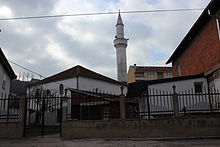
Pristina is the capital and largest city of Kosovo. It is the administrative center of the eponymous municipality and district.

The Mosque Katip Sinan Qelebi, also known as "Katip Çelebi", is located on the Adem Jashari Street in Prizren, Kosovo. Katip means "secretary" in Turkish. It may be named after Katip Çelebi but it also may be named like the Plaošnik mosque in Ohrid, which was named after Sinaneddin Yusuf Çelebi, short form Sinan Çelebi, from the Ohrizâde family.
Tingulli 3nt, also known as Tingulli Trent, is a Kosovo-Albanian hip hop group formed in 1996. The group members are Getoar Selimi and Agon Amiga. His brother "Liberian Selimi" was also active in the rap scene during his teenage years. Tingulli 3nt took the Albanian music scene by a storm in the early 2000s with their always innovative, groundbreaking songs and music videos. In the late 2000s it became the most known and the most influential hip hop group in the scene. In the summer of 2010 Tingulli 3nt collaborated with Ermal Fejzullahu, a famous Albanian folk singer. The video of the song was reportedly censured, because of the excessive nudity exposed in the images.
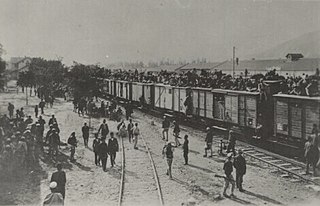
The Albanian revolt of 1912 was the last revolt against the Ottoman Empire's rule in Albania and lasted from January until August 1912. The revolt ended when the Ottoman government agreed to fulfill the rebels' demands on 4 September 1912. Generally, Muslim Albanians fought against the Ottomans then governed by the Committee of Union and Progress.
Tourism in Kosovo is characterized by archaeological heritage from Illyrian, Dardanian, Roman, Byzantine, Serbian and Ottoman times, traditional Albanian and Serbian cuisine, architecture, religious heritage, traditions, and natural landscapes. Kosovo is situated in south-eastern Europe. With its central position in the Balkans, it serves as a link in the connection between central and south Europe, the Adriatic Sea, and Black Sea.

Archaeology of Kosovo as a field of study and research was started in the second half of the 20th century. Kosovo's field of archaeology has developed in tandem with the historical study, studies of ancient authors' sources, classic philological studies, theological data research, topographic studies and ground survey, analysis of toponyms, deciphering of epigraphic and historiographic data. First data about antique monuments in Kosovo, were documented from the end of the 19th until the beginning of the Second World War, a time period when Kosovo was visited by researchers, guides, and archaeologists such as: Evans, Boue, Hahn, Kanitz, Tomaschek, Domaschevski, Arpad, Vulic, Jirecek, Patsch, Domenico Mustilli, etc.
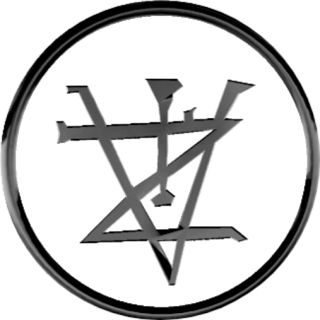
Viciana or Station Viciano was a Roman road station of unclear location, somewhere in Kosovo field.

The Bazaar of Prishtina, Kosovo, was the core merchandising center of the Old Prishtina since the 15th century, when it was built. It played a significant role in the physical, economic, and social development of Pristina. The Old Bazaar was destroyed during the 1950s and 1960s, following the modernization slogan of "Destroy the old, build the new". In its place, buildings of Kosovo Assembly, Municipality of Prishtina, PTT, and Brotherhood and Unity socialist square were built. Nowadays, instead of PTT building resides the Government of Kosovo building. Only few historical buildings, such as the Bazaar Mosque and ruins of the Bazaar Hammam have remained from the Bazaar complex. Since then, Prishtina has lost part of its identity, and its cultural heritage has been scattered.

The Great Hammam of Pristina is an Ottoman-era monument in Pristina, Kosovo. It was built in the 15th century and was part of the Imperial Mosque. During the summer and spring, it was used as a meeting place. Considered one of the most important buildings of the cultural and historical heritage, the Great Hammam of Pristina was in poor condition through the years until its restoration was approved.
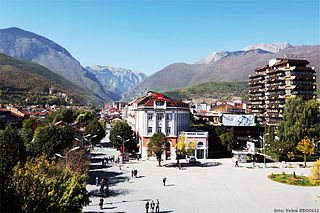
The architecture of Peja, Kosovo, describes a large mixture of architectural structures which are a reflection of the influential foreign rule all across the city. The architecture of the city consists of buildings, structures and constructions which were built with an architectural influence of the Byzantine architecture, Serbo-Byzantine architecture, Ottoman architecture, Stalinist architecture, and Modern cultures/architectures. Because of this there are many churches, mosques, buildings which are attraction points in the city and were built by the aforementioned influences. The rule of the Ottoman and Serbian empires and the historical influence of former Yugoslavia have shaped the architectural landscape of the city to become a conglomerate of cultures.

Tourism in Pristina attracted 36,186 foreign visitors in 2012, which represents 74.2% of all visitors that visited Kosovo during that year. Foreign visitors mostly come from countries like Albania, Turkey, Germany, United States, Slovenia and North Macedonia, but also from other countries. Some of the most visited places in Pristina are Lake Batllava and Gadime Marble Cave, which are also among the most visited places in Kosovo.
The architecture of Kosovo dates back to the Neolithic period and includes the Copper, Bronze and Iron Ages, Antiquity and the Medieval period. It has been influenced by the presence of different civilizations and religions as evidenced by the structures which have survived to this day. Local builders have combined building techniques of conquering empires with the materials at hand and the existing conditions to develop their own varieties of dwellings.
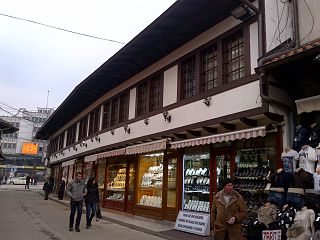
Bazaar of Peja or Peja market is a market place in the center of the city of Peja, in Kosovo. It was established during Ottoman rule and is located near the Lumbardhi i Pejës river, between parallel residence zones. The market historically housed blacksmiths and carpenters but also facilitated the agricultural market. The market place was completely destroyed at least twice, once during the Italian occupation in 1943, and once during the Kosovo War (1998–99). The market was fully rebuilt after the Kosovo War, according to the historical Ottoman architecture, and serves as the main market in the city of Peja, and is one of the many monuments which are under protection by the Republic of Kosovo. The main street of the market is known in Albanian as Çarshia e Gjatë.

The Hamam of Peja or Old Bath is an Ottoman bath in Peja, Kosovo, built in the second half of the 15th century. The building consists of an asymmetric "double" bath. According to some sources the bath was reconstructed in 1861 for unknown reasons. The bath was damaged during war and was reconstructed after. Today, the hammam serves as an exhibition hall for different art shows and more.

The Jashar Pasha Mosque is a historical mosque in Prishtina, Kosovo. The mosque was built in 1834 by the mayor of Skopje, Mehmet Yasar.

Prishtina Bus Station is the main bus station in Prishtina, Kosovo, 2 km south-west of the city, near Bill Clinton Boulevard. Prishtina bus station is composed by a bus depot and bus terminals, responsible to provides transport to the rest of Kosovo and continental destinations.

The Çarshi Mosque, also known as the Bazaar Mosque and the Taş Mosque, is the oldest building in Pristina, Kosovo, and it marks the beginning of the old town. The foundation of this mosque was laid out in 1389 during the rule of the Ottoman Sultan Bayezid I and its construction was continued during the reign of Sultan Murad II in the 15th century. The Çarshi Mosque was built to celebrate the Ottoman victory of 1389 in the Battle of Kosovo. Over the years, the mosque has undergone through several restorations. However, its stone-topped minaret has survived for over six centuries.

Shadërvan is a marble fountain located between the Çarshi Mosque and the Museum of Kosovo in Pristina, Kosovo, and is a typical component of Ottoman architecture. The fountain is the only one remaining in the city from over fifty that once existed. In addition to providing a source of drinkable water, Shadërvan has been traditionally used for ritual ablution.

The Clock Tower in Pristina, Kosovo, was built in the 19th century by Jashar Pasha, after whom the Mosque is named not far from the Clock Tower. It served as a means of informing the town during the Ottoman Empire rule, in order to let people know when to pray as well as the traders closing their shops. The 26-meter high hexagonal clock tower was made of sandstone and bricks. The original tower was burned in fire and its bricks were used for reconstruction. The authentic bell was brought from Moldavia and has an inscription mentioning this fact. However, the circumstances of how the bell was brought to Pristina are not clearly known; its theft in 2001 is even more unclear. The same year, French KFOR troops assisted in installing a new clock by changing the old clock mechanism with an electric one.




